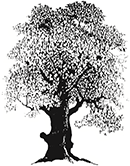MAINE-LY GARDENING: What’s in the house? Poinsettias

 by Jude Hsiang
by Jude Hsiang
Poinsettias are another plant we use to add holiday color to our homes. They are another tropical plant, in this case from Mexico, where it is a perennial garden shrub. In our cooler temperate area, the plants are forced to bloom now, but with care they will brighten our days for weeks.
It is sometimes thought that poinsettias are poisonous, but they are safe to have around people. The white milky sap can cause stomach upset if eaten, but is very unlikely to be tempting. However, some dogs and cats might give it a try, so be sure to keep this plant out of their reach.
Horticulturalists – always looking for new colors, shapes and sizes of plants – have developed a range of shades from the original red. You may find white, cream, pink, salmon, and even yellow flowered poinsettias. Blue flowers have been dyed.
We call the large blooms flowers, but more actually the true flowers are the tiny yellow clusters in the center. You can examine them with a magnifier to see the flower parts. The larger red, or other colored, “petals” are modified leaves called bracts. Other familiar plants with bracts surrounding little true flowers are the dogwoods.
Poinsettias offered for sale should be protected from the cold. They are often displayed with a plastic wrap for protection. Even a few seconds outdoors at this time of year can cause them to drop their leaves and flowers. I once visited a store in mid November that had arranged a large display of poinsettias right inside the entrance, where automatic doors swung wide open to the frosty air as people came and went. That was certainly a reminder to buy plants from people who really know plants!
Once your poinsettia is safely home it will want a little care from you. These plants are not terribly fussy but they do have some requirements like any living thing.
They need six to eight hours of bright sunlight, but should be set a few feet away from a window. Too much hot sun through the glass can burn the leaves. On the other hand, leaves that touch the glass can be killed when it cools at night.
If your poinsettias were wrapped in foil and you want to keep it as a decoration, be sure to punch a few holes in the foil to allow drainage. When the surface of the soil is dry, water the plant enough to cause the water to drain through the holes, then set it back in its dry saucer. These plants are among those that can’t tolerate being in standing water.
Like many other plants we enjoy inside, these have evolved in tropical areas with bright filtered sunlight, soil that drains before it can become soggy, and more humidity than we humans like. If your house is quite dry at this time of year, set a dish of water nearby to add a bit of moisture through evaporation. Typical indoor temperatures are fine, but protect the poinsettia from cold drafts. If the room cools below 60 degrees at night, just move the plant to a warmer spot until morning.
Attending to these needs aren’t much work when you consider the joy of having this beautiful plant in your home for the holidays.
Poinsettias can be kept for years, with some very exacting requirements, including a dark period in the fall to encourage blooming around the holidays, which is not their natural cycle. Research the steps that need to be followed through the year and you may be able to keep your poinsettia happily blooming again and again.
© Judith Chute Hsiang
Jude Hsiang is a retired Extension Master Gardener instructor and member of the China Community Garden.
Responsible journalism is hard work!
It is also expensive!
If you enjoy reading The Town Line and the good news we bring you each week, would you consider a donation to help us continue the work we’re doing?
The Town Line is a 501(c)(3) nonprofit private foundation, and all donations are tax deductible under the Internal Revenue Service code.
To help, please visit our online donation page or mail a check payable to The Town Line, PO Box 89, South China, ME 04358. Your contribution is appreciated!


Leave a Reply
Want to join the discussion?Feel free to contribute!